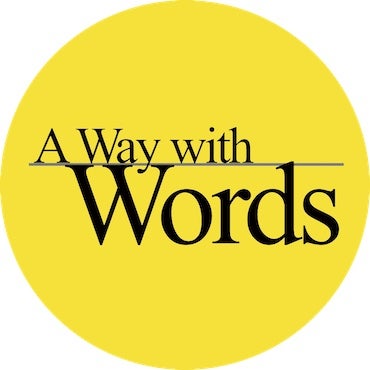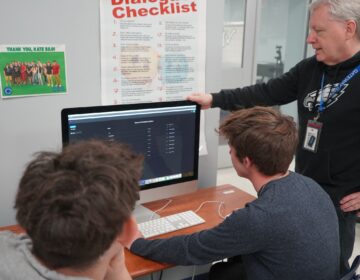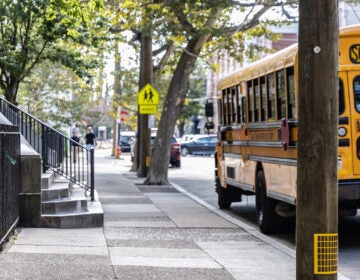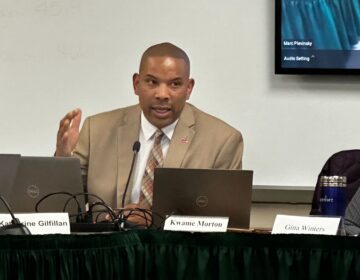Which Philly schools don’t have instrumental music?
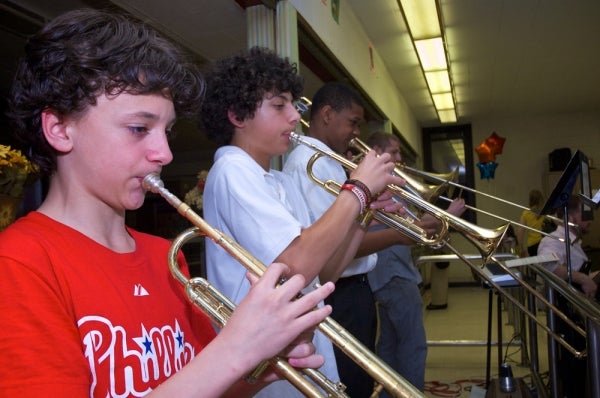
(Bas Slabbers/NewsWorks file photo)
As the School District of Philadelphia rebuilds its music program, data shows that more than 50 schools still don’t have instrumental music instruction through the district — and that those schools serve disproportionately high numbers of minority students.
The new numbers come courtesy of City Councilwoman Helen Gym’s office, which requested them from the district.
The school district has 66 itinerant instrumental music teachers who travel from school to school and another 20 school-based instrumental music teachers. Despite the efforts of those teachers, 51 Philadelphia schools do not have any sort of instrumental music instruction provided by the district.
The schools without instrumental music are concentrated in North and West Philadelphia. They also tend to serve relatively few white students.
Districtwide, white students make up 13.81 percent of the student body. But at the 51 Philadelphia schools without instrumental music, 50 have a lower-than-average ratio of white students.
Meanwhile, according to an analysis by Gym’s office, among district school where at least a third of students are white, all offer instrumental music.
“When the data shows that black and Latino youth in the poorest sections of the city are denied access to arts in schools, we have to do something about it,” said Gym.
Though there’s a correlation between schools without instrumental music instruction and schools serving minority students, establishing cause is far trickier.
Some schools don’t ask for music
Building principals are given the option of selecting instrumental music, according to the district. Sometimes, principals simply don’t ask for music.
“Principals ask us if they want to increase the number of hours for instrumental music in their schools,” said chief academic officer Cheryl Logan, when questioned about the discrepancy at a budget hearing before City Council last week.”We have some schools where there isn’t a request.”
James Williams, principal at Kensington Health Sciences Academy, doesn’t ask for music instruction because he feels his school’s resources can be better allocated elsewhere.
KHSA belongs to a cluster of Kensington high schools with different specialties. Kensington Creative and Performing Arts High School, which has three itinerant music teachers rotating through its school, focuses on students interested in music or arts. KHSA tries to prepare students for careers in health care.
“We’re kind of a unique, hybrid-cohort of schools in the same neighborhood,” Williams said.
“I know those needs are going to be met by my sister school for students have that interest [in music].”
Gym, however, believes many principals aren’t selecting music because of competing interests.
“I don’t find it surprising that principals aren’t asking for music,” said Gym. “I think that too often music and arts in particular are seen as non-essential when you’re dealing with urgent staffing issues around climate and counseling and teaching staff.”
That’s the case at Paul Robeson High School for Human Services in West Philadelphia, which was recently honored by the district for high academic performance.
Principal Richard Gordon IV would gladly add music as an elective or even an after-school offering, but feels he needs more resources directed toward basic supplies, lowering class sizes, and ensuring building security.
“How do you balance such an expensive offering with the other budget priorities you have to address to effectively run your schools,” he asked.
During budget cuts a few years back, Gordon said, many principals felt they had to choose between visual arts and music. Gordon chose arts because the school had a beloved art teacher — and it’s an easier offering to maintain than music, which requires extensive instrument maintenance, he said.
Though intinerant music teachers are centrally budgeted at no cost to schools, school-based music teachers come out of individual school budget’s, according to the district.
“It’s less of a headache to have art because that just involves going online and buying supplies,” he said.
Partnering with Philly POPS
In other cases, though, principals want instrumental music instruction, but don’t receive it.
For two years, Marisol Rivera Rodriguez, principal at Isaac Sheppard School in Fairhill, has requested instrumental music instruction from the district, she said. The district has not, however, assigned the K-4 school any itinerant or permanent instructors.
“Unfortunately we did not make the list,” Rodriguez said. “But that had nothing to do with our advocacy and wanting the program.”
Rodriguez has found an alternate way to introduce music education. Through a partnership with the Philly POPS Orchestra, Sheppard offered violin instruction to its kindergarten students for the first time this school year. Rodriguez hopes to grow the partnership in future years and expand the number of grades receiving instruction.
The number of itinerant instrumental music teachers has held steady since 2013-14 at 66. The district has, however, boosted its overall musical offerings — choral and instrumental — in recent years. There are now 225 music teachers in the district compared to 212 in 2013-14.
Logan, the district’s chief academic officer, said Wednesday Philadelphia schools would add seven more itinerant instrumental music teachers next school year.
It’s unclear, however, how many more schools that will cover. Below are the schools that do not have either an itinerant or full-time instrumental music teacher.
| SCHOOL | COUNCIL DISTRICT |
| Furness HS | 1 |
| Constitution HS | 1 |
| Mastbaum HS | 1 |
| Kensington Health Sciences HS | 1 |
| Kensington HS | 1 |
| Paul Robeson HS | 3 |
| Sayre HS | 3 |
| B.B. Comegys | 3 |
| A.D. Harrington | 3 |
| Morton McMichael | 3 |
| S. Weir Mitchell | 3 |
| James Rhoads | 3 |
| Philadelphia Juvenile Justice Services Center | 3 |
| Parkway West HS | 3 |
| PLA – South | 3 |
| The Workshop School | 3 |
| Crossroads Accelerated Academy | 3 |
| John Barry | 4 |
| Science Leadership Academy at Beeber | 4 |
| W.B. Saul HS | 4 |
| Randolph Technical HS | 4 |
| Lankenau HS | 4 |
| Science Leadership Academy Middle School | 5 |
| Laura Waring | 5 |
| Murrell Dobbins HS | 5 |
| William Dick | 5 |
| Tanner Duckrey | 5 |
| Richard Wright | 5 |
| W.D. Kelley | 5 |
| Philadelphia Military Academy | 5 |
| Parkway Center City HS | 5 |
| Penn Treaty HS | 5 |
| The U School | 5 |
| Strawberry Mansion HS | 5 |
| Mary Bethune | 5 |
| Pennypack House School | 6 |
| Crossroads at Hunting Park | 7 |
| Isaac Sheppard | 7 |
| William Cramp | 7 |
| Philip Sheridan | 7 |
| The Linc | 7 |
| Barton | 7 |
| John Marshall | 7 |
| Alexander McClure | 7 |
| Kenderton | 8 |
| Parkway Northwest HS | 8 |
| James Logan | 8 |
| Edward Steel | 8 |
| Widener Memorial | 8 |
| Howe Academics Plus | 9 |
| PLA – North | 9 |
Gym’s office also tracked the locations of schools lacking instrumental music.
A combined 25 were in districts represented by Councilman Darrell Clarke and Councilwoman Jannie Blackwell, covering parts of North and West Philadelphia respectively. In Councilwoman Maria Quiñones-Sánchez’s district, which covers the lower Northeast, eight schools are on the no-music list.
Councilman Brian O’Neill, who represents the far Northeast, and Councilman Kenyatta Johnson, who serves West and Southwest Philadelphia, had no schools without instrumental music.
Update: This article has been updated to clarify that intinernant music teachers are centrally budgted, but school-based music teachers come out of individual school budgets.
WHYY is your source for fact-based, in-depth journalism and information. As a nonprofit organization, we rely on financial support from readers like you. Please give today.

